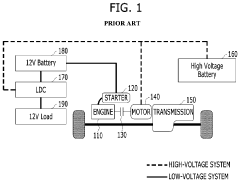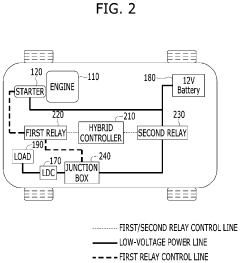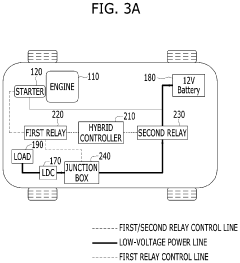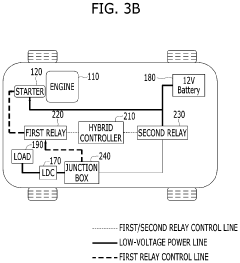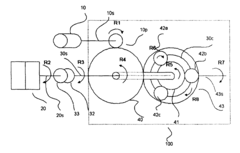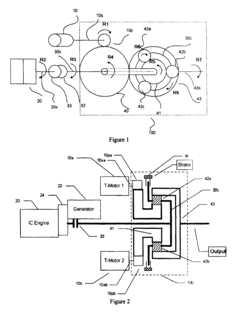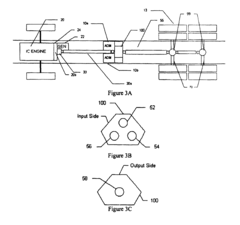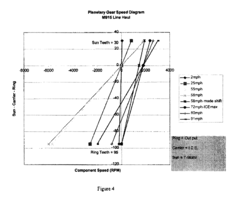How to Develop Robust HEV Economies in Urban Centers?
AUG 14, 20258 MIN READ
Generate Your Research Report Instantly with AI Agent
Patsnap Eureka helps you evaluate technical feasibility & market potential.
HEV Technology Evolution and Urban Mobility Goals
The evolution of Hybrid Electric Vehicle (HEV) technology has been closely intertwined with the goals of urban mobility and sustainability. Over the past two decades, HEVs have emerged as a crucial stepping stone in the transition from conventional internal combustion engine vehicles to fully electric vehicles. This technological progression has been driven by the urgent need to address urban air pollution, reduce greenhouse gas emissions, and enhance energy efficiency in transportation.
The primary objective of HEV technology in urban centers is to create a more sustainable and efficient transportation ecosystem. This goal aligns with broader urban mobility targets, including reducing traffic congestion, improving air quality, and enhancing overall quality of life for city dwellers. HEVs offer a compromise between the familiarity of traditional vehicles and the environmental benefits of electric propulsion, making them an attractive option for urban commuters and fleet operators.
As urban populations continue to grow, the demand for personal mobility solutions that can operate efficiently in congested environments has intensified. HEVs address this need by offering improved fuel economy and reduced emissions, particularly in stop-and-go traffic conditions typical of urban areas. The technology's ability to recover energy through regenerative braking and optimize power distribution between the electric motor and internal combustion engine makes it particularly well-suited for urban driving patterns.
The evolution of HEV technology has been marked by continuous improvements in battery capacity, power management systems, and overall vehicle efficiency. Early HEV models focused primarily on fuel economy gains, while more recent iterations have expanded their electric-only driving range and power output. This progression has led to the development of plug-in hybrid electric vehicles (PHEVs), which offer extended electric-only operation and further reduce reliance on fossil fuels.
Looking ahead, the goals for HEV technology in urban mobility are becoming increasingly ambitious. Future developments aim to seamlessly integrate HEVs into smart city infrastructures, leveraging vehicle-to-grid (V2G) technologies to support urban power grids during peak demand periods. Additionally, there is a push towards incorporating advanced driver assistance systems (ADAS) and autonomous driving capabilities into HEVs, further enhancing their suitability for urban environments.
The primary objective of HEV technology in urban centers is to create a more sustainable and efficient transportation ecosystem. This goal aligns with broader urban mobility targets, including reducing traffic congestion, improving air quality, and enhancing overall quality of life for city dwellers. HEVs offer a compromise between the familiarity of traditional vehicles and the environmental benefits of electric propulsion, making them an attractive option for urban commuters and fleet operators.
As urban populations continue to grow, the demand for personal mobility solutions that can operate efficiently in congested environments has intensified. HEVs address this need by offering improved fuel economy and reduced emissions, particularly in stop-and-go traffic conditions typical of urban areas. The technology's ability to recover energy through regenerative braking and optimize power distribution between the electric motor and internal combustion engine makes it particularly well-suited for urban driving patterns.
The evolution of HEV technology has been marked by continuous improvements in battery capacity, power management systems, and overall vehicle efficiency. Early HEV models focused primarily on fuel economy gains, while more recent iterations have expanded their electric-only driving range and power output. This progression has led to the development of plug-in hybrid electric vehicles (PHEVs), which offer extended electric-only operation and further reduce reliance on fossil fuels.
Looking ahead, the goals for HEV technology in urban mobility are becoming increasingly ambitious. Future developments aim to seamlessly integrate HEVs into smart city infrastructures, leveraging vehicle-to-grid (V2G) technologies to support urban power grids during peak demand periods. Additionally, there is a push towards incorporating advanced driver assistance systems (ADAS) and autonomous driving capabilities into HEVs, further enhancing their suitability for urban environments.
Urban Market Demand for HEV Solutions
The demand for Hybrid Electric Vehicle (HEV) solutions in urban centers has been steadily growing, driven by increasing environmental concerns, rising fuel costs, and supportive government policies. Urban areas, characterized by high population density and frequent short-distance trips, provide an ideal ecosystem for HEV adoption.
Market research indicates that urban consumers are increasingly prioritizing fuel efficiency and environmental impact when making vehicle purchasing decisions. This shift in consumer preferences has created a significant market opportunity for HEVs in city environments. The stop-and-go nature of urban traffic patterns aligns well with HEV technology, which excels in energy recovery during braking and low-speed operations.
The urban HEV market is segmented into various categories, including passenger cars, commercial vehicles, and public transportation. Among these, the passenger car segment currently dominates the market share, with a growing interest in compact and mid-size HEV models suitable for city driving. However, there is also an emerging demand for HEV solutions in urban logistics and public transportation sectors.
Fleet operators and businesses in urban areas are showing increased interest in HEV technology as a means to reduce operational costs and meet sustainability targets. This trend is particularly evident in the taxi and ride-sharing industries, where the economic benefits of lower fuel consumption can significantly impact profitability.
Urban infrastructure development plays a crucial role in supporting HEV adoption. The demand for charging stations and smart grid integration is rising, creating additional market opportunities for infrastructure providers and energy management companies. Cities are increasingly investing in HEV-friendly infrastructure as part of their sustainable urban development plans.
Consumer surveys reveal that urban dwellers are attracted to HEVs for their lower environmental impact, potential fuel savings, and reduced maintenance costs. However, concerns about initial purchase price, battery life, and charging infrastructure availability remain barriers to wider adoption. Addressing these concerns through technological advancements and policy support is crucial for expanding the urban HEV market.
The market demand for HEVs in urban centers is not uniform across all regions. Developed urban areas with higher income levels and stronger environmental regulations tend to show stronger demand. However, rapidly growing cities in emerging economies are also presenting significant growth opportunities as they seek to address air quality issues and reduce dependence on fossil fuels.
Market research indicates that urban consumers are increasingly prioritizing fuel efficiency and environmental impact when making vehicle purchasing decisions. This shift in consumer preferences has created a significant market opportunity for HEVs in city environments. The stop-and-go nature of urban traffic patterns aligns well with HEV technology, which excels in energy recovery during braking and low-speed operations.
The urban HEV market is segmented into various categories, including passenger cars, commercial vehicles, and public transportation. Among these, the passenger car segment currently dominates the market share, with a growing interest in compact and mid-size HEV models suitable for city driving. However, there is also an emerging demand for HEV solutions in urban logistics and public transportation sectors.
Fleet operators and businesses in urban areas are showing increased interest in HEV technology as a means to reduce operational costs and meet sustainability targets. This trend is particularly evident in the taxi and ride-sharing industries, where the economic benefits of lower fuel consumption can significantly impact profitability.
Urban infrastructure development plays a crucial role in supporting HEV adoption. The demand for charging stations and smart grid integration is rising, creating additional market opportunities for infrastructure providers and energy management companies. Cities are increasingly investing in HEV-friendly infrastructure as part of their sustainable urban development plans.
Consumer surveys reveal that urban dwellers are attracted to HEVs for their lower environmental impact, potential fuel savings, and reduced maintenance costs. However, concerns about initial purchase price, battery life, and charging infrastructure availability remain barriers to wider adoption. Addressing these concerns through technological advancements and policy support is crucial for expanding the urban HEV market.
The market demand for HEVs in urban centers is not uniform across all regions. Developed urban areas with higher income levels and stronger environmental regulations tend to show stronger demand. However, rapidly growing cities in emerging economies are also presenting significant growth opportunities as they seek to address air quality issues and reduce dependence on fossil fuels.
HEV Integration Challenges in Urban Infrastructure
The integration of Hybrid Electric Vehicles (HEVs) into urban infrastructure presents significant challenges that must be addressed to develop robust HEV economies in urban centers. One of the primary obstacles is the need for extensive charging infrastructure. Urban areas often lack sufficient space for widespread installation of charging stations, particularly in densely populated neighborhoods with limited parking facilities. This scarcity of charging points can lead to range anxiety among HEV users and hinder adoption rates.
Another critical challenge is the strain on the existing power grid. As HEV adoption increases, the demand for electricity will surge, potentially overwhelming urban power systems that were not designed to handle such loads. This issue is particularly acute during peak hours when both residential and commercial power consumption is high. Upgrading the grid infrastructure to accommodate this increased demand requires significant investment and careful planning to ensure reliability and stability.
Traffic management systems in urban areas also face challenges with the integration of HEVs. These vehicles often have different performance characteristics compared to conventional vehicles, such as instant torque and regenerative braking. Existing traffic flow models and signal timing systems may need to be adjusted to optimize for mixed fleets of HEVs and traditional vehicles, ensuring smooth traffic flow and maximizing energy efficiency.
The integration of HEVs also raises concerns about urban noise pollution. While HEVs are generally quieter than conventional vehicles, this can pose safety risks for pedestrians and cyclists who may not hear approaching vehicles. Urban planners must consider implementing new safety measures, such as acoustic vehicle alerting systems or redesigned pedestrian crossings, to mitigate these risks.
Furthermore, the recycling and disposal of HEV batteries present a significant environmental challenge for urban centers. As the number of HEVs increases, cities must develop robust systems for collecting, processing, and recycling end-of-life batteries to prevent environmental contamination and recover valuable materials. This requires specialized facilities and trained personnel, which may not be readily available in many urban areas.
Lastly, the integration of HEVs into urban car-sharing and ride-hailing services presents both opportunities and challenges. While these vehicles can reduce emissions and operating costs for such services, they require careful management of charging schedules and vehicle availability to ensure consistent service levels. Urban planners and service providers must collaborate to develop efficient systems that balance charging needs with service demands, potentially involving the strategic placement of fast-charging stations and the implementation of smart scheduling algorithms.
Another critical challenge is the strain on the existing power grid. As HEV adoption increases, the demand for electricity will surge, potentially overwhelming urban power systems that were not designed to handle such loads. This issue is particularly acute during peak hours when both residential and commercial power consumption is high. Upgrading the grid infrastructure to accommodate this increased demand requires significant investment and careful planning to ensure reliability and stability.
Traffic management systems in urban areas also face challenges with the integration of HEVs. These vehicles often have different performance characteristics compared to conventional vehicles, such as instant torque and regenerative braking. Existing traffic flow models and signal timing systems may need to be adjusted to optimize for mixed fleets of HEVs and traditional vehicles, ensuring smooth traffic flow and maximizing energy efficiency.
The integration of HEVs also raises concerns about urban noise pollution. While HEVs are generally quieter than conventional vehicles, this can pose safety risks for pedestrians and cyclists who may not hear approaching vehicles. Urban planners must consider implementing new safety measures, such as acoustic vehicle alerting systems or redesigned pedestrian crossings, to mitigate these risks.
Furthermore, the recycling and disposal of HEV batteries present a significant environmental challenge for urban centers. As the number of HEVs increases, cities must develop robust systems for collecting, processing, and recycling end-of-life batteries to prevent environmental contamination and recover valuable materials. This requires specialized facilities and trained personnel, which may not be readily available in many urban areas.
Lastly, the integration of HEVs into urban car-sharing and ride-hailing services presents both opportunities and challenges. While these vehicles can reduce emissions and operating costs for such services, they require careful management of charging schedules and vehicle availability to ensure consistent service levels. Urban planners and service providers must collaborate to develop efficient systems that balance charging needs with service demands, potentially involving the strategic placement of fast-charging stations and the implementation of smart scheduling algorithms.
Current Urban HEV Implementation Strategies
01 Economic resilience strategies for HEV adoption
Developing strategies to enhance economic resilience in the context of HEV (Hybrid Electric Vehicle) adoption. This includes creating robust economic models, incentive programs, and infrastructure development plans to support the transition to HEV technologies while maintaining economic stability.- Economic resilience strategies for HEV adoption: Developing strategies to enhance economic resilience in the context of HEV (Hybrid Electric Vehicle) adoption. This includes creating robust economic models, incentive programs, and infrastructure development plans to support the transition to HEV technologies while maintaining economic stability.
- HEV supply chain optimization: Improving the robustness of HEV economies through supply chain optimization. This involves enhancing the efficiency and reliability of component sourcing, manufacturing processes, and distribution networks specific to HEV production and maintenance.
- Energy management systems for HEV economies: Developing advanced energy management systems to support HEV economies. This includes creating smart grid solutions, efficient charging infrastructure, and energy storage technologies to ensure a stable and sustainable energy supply for HEV operations.
- HEV technology innovation and integration: Fostering innovation in HEV technologies and their integration into existing economic systems. This involves research and development of new HEV components, software solutions, and integration strategies to enhance the overall performance and economic viability of HEV adoption.
- Policy frameworks for sustainable HEV economies: Establishing comprehensive policy frameworks to support the development of robust HEV economies. This includes creating regulations, standards, and incentives that promote HEV adoption, ensure fair competition, and address potential economic challenges associated with the transition to HEV technologies.
02 Technological advancements in HEV systems
Focusing on technological improvements in HEV systems to increase efficiency, reduce costs, and enhance overall performance. This includes innovations in battery technology, power management systems, and drivetrain components to make HEVs more economically viable and competitive in the automotive market.Expand Specific Solutions03 Supply chain optimization for HEV production
Developing robust supply chain strategies to ensure a stable and efficient production of HEVs. This involves managing raw material sourcing, component manufacturing, and distribution networks to minimize disruptions and maintain economic stability in the HEV industry.Expand Specific Solutions04 Policy frameworks for sustainable HEV economies
Establishing comprehensive policy frameworks to support the growth of HEV economies. This includes developing regulations, standards, and incentives that promote HEV adoption while ensuring economic stability and environmental sustainability.Expand Specific Solutions05 Market analysis and consumer behavior in HEV adoption
Conducting in-depth market analysis and studying consumer behavior patterns related to HEV adoption. This research helps in understanding market trends, consumer preferences, and potential barriers to HEV adoption, enabling the development of targeted strategies to enhance economic robustness in the HEV sector.Expand Specific Solutions
Key Players in Urban HEV Ecosystem
The development of robust Hybrid Electric Vehicle (HEV) economies in urban centers is currently in a growth phase, with increasing market size and technological advancements. The global HEV market is expanding rapidly, driven by environmental concerns and government incentives. Technologically, HEVs are maturing, with major players like GM, Ford, Hyundai, and Toyota leading innovation. Chinese manufacturers such as BYD, Geely, and Chery are also making significant strides, particularly in their domestic market. The involvement of diverse companies, from traditional automakers to new entrants like CRRC Electric Vehicle, indicates a competitive and evolving landscape. Universities and research institutions are contributing to technological progress, suggesting ongoing improvements in HEV efficiency and performance.
Ford Global Technologies LLC
Technical Solution: Ford's strategy for HEV economies in urban centers is centered on their PowerSplit hybrid technology. This system allows for seamless transition between electric and gasoline power, optimized for urban driving patterns[7]. Ford has developed an intelligent range calculation system that factors in urban traffic patterns, weather, and topography to provide accurate electric range estimates. Their HEVs feature advanced regenerative braking systems that capture up to 94% of braking energy, significantly extending electric range in city driving[8]. Ford has also implemented vehicle-to-grid (V2G) technology in their HEVs, allowing them to serve as mobile power sources during urban power outages or peak demand periods[9].
Strengths: Advanced energy recapture systems, intelligent range prediction, and V2G capabilities. Weaknesses: Less extensive hybrid lineup compared to some competitors, higher initial vehicle costs.
Hyundai Motor Co., Ltd.
Technical Solution: Hyundai's approach to HEV economies in urban centers focuses on their Blue Drive technology. This system incorporates a compact lithium-polymer battery and a high-efficiency electric motor, optimized for urban driving conditions[10]. Hyundai has developed an Eco-Driving Assist System that provides real-time feedback to drivers, encouraging more efficient driving habits in city environments. Their HEVs feature an advanced parallel hybrid system that allows for full EV mode in low-speed urban settings, seamlessly switching to hybrid mode for higher speeds or when battery charge is low[11]. Hyundai has also invested in lightweight materials and aerodynamic designs to further improve urban fuel efficiency.
Strengths: Efficient parallel hybrid system, driver assistance for eco-driving, lightweight vehicle design. Weaknesses: Limited charging infrastructure compared to some competitors, lower brand recognition in the HEV market.
Innovative HEV Technologies for Urban Environments
Hybrid electric vehicle and method of controlling the same
PatentActiveUS11794720B2
Innovation
- A hybrid electric vehicle system with a first relay to control the starter and a second relay between the DC-DC converter and the electric load, along with a controller that adjusts their states to maintain stable engine cranking by compensating for the DC-DC converter failure by operating the engine clutch in a slip state and increasing the driving motor's torque for kinetic energy.
Power combining apparatus for hybrid electric vehicle
PatentInactiveUSRE41034E1
Innovation
- A vehicle transmission system utilizing a planetary gear set with a clutch and brake mechanism, enabling operation in three modes: mechanical, electrical, and combined, with a torque transmitting arrangement to synchronize power sources and optimize power transmission efficiency.
Policy Framework for Urban HEV Adoption
Developing a robust policy framework is crucial for the successful adoption of Hybrid Electric Vehicles (HEVs) in urban centers. This framework should encompass a multi-faceted approach, addressing various aspects of urban planning, infrastructure development, and economic incentives.
At the core of this policy framework should be a set of clear and ambitious targets for HEV adoption. These targets should be time-bound and measurable, providing a roadmap for both public and private sectors to align their efforts. For instance, cities could aim to have 30% of all new vehicle registrations be HEVs by 2025, increasing to 50% by 2030.
To support these targets, cities should implement a comprehensive set of financial incentives. These could include purchase subsidies for HEVs, tax rebates, and reduced registration fees. Additionally, operational incentives such as free or discounted parking, access to high-occupancy vehicle lanes, and exemptions from congestion charges can make HEV ownership more attractive to urban residents.
Infrastructure development is another critical component of the policy framework. Cities should mandate the installation of charging stations in new residential and commercial developments. Public-private partnerships can be leveraged to accelerate the deployment of charging infrastructure in existing urban areas. Zoning laws should be updated to facilitate the integration of charging stations into the urban landscape.
The policy framework should also address the regulatory environment. This includes streamlining the process for obtaining permits for charging infrastructure, updating building codes to accommodate HEV charging needs, and establishing standards for charging equipment to ensure interoperability and safety.
Education and awareness campaigns form an essential part of the policy framework. These initiatives should aim to inform the public about the benefits of HEVs, available incentives, and the location of charging infrastructure. Partnerships with local dealerships, community organizations, and educational institutions can help disseminate this information effectively.
Lastly, the policy framework should include provisions for regular review and adaptation. As technology evolves and adoption rates change, policies may need to be adjusted to remain effective. A dedicated task force or committee should be established to monitor progress, gather feedback from stakeholders, and recommend policy updates as needed.
At the core of this policy framework should be a set of clear and ambitious targets for HEV adoption. These targets should be time-bound and measurable, providing a roadmap for both public and private sectors to align their efforts. For instance, cities could aim to have 30% of all new vehicle registrations be HEVs by 2025, increasing to 50% by 2030.
To support these targets, cities should implement a comprehensive set of financial incentives. These could include purchase subsidies for HEVs, tax rebates, and reduced registration fees. Additionally, operational incentives such as free or discounted parking, access to high-occupancy vehicle lanes, and exemptions from congestion charges can make HEV ownership more attractive to urban residents.
Infrastructure development is another critical component of the policy framework. Cities should mandate the installation of charging stations in new residential and commercial developments. Public-private partnerships can be leveraged to accelerate the deployment of charging infrastructure in existing urban areas. Zoning laws should be updated to facilitate the integration of charging stations into the urban landscape.
The policy framework should also address the regulatory environment. This includes streamlining the process for obtaining permits for charging infrastructure, updating building codes to accommodate HEV charging needs, and establishing standards for charging equipment to ensure interoperability and safety.
Education and awareness campaigns form an essential part of the policy framework. These initiatives should aim to inform the public about the benefits of HEVs, available incentives, and the location of charging infrastructure. Partnerships with local dealerships, community organizations, and educational institutions can help disseminate this information effectively.
Lastly, the policy framework should include provisions for regular review and adaptation. As technology evolves and adoption rates change, policies may need to be adjusted to remain effective. A dedicated task force or committee should be established to monitor progress, gather feedback from stakeholders, and recommend policy updates as needed.
Economic Impact of HEV Integration in Urban Centers
The integration of Hybrid Electric Vehicles (HEVs) into urban centers has the potential to significantly impact local economies. As cities transition towards more sustainable transportation systems, the economic implications of HEV adoption extend far beyond the automotive sector. This shift creates new opportunities for job creation, particularly in areas such as vehicle manufacturing, maintenance, and charging infrastructure development.
The increased presence of HEVs in urban areas can lead to the emergence of new businesses and services. Charging station operators, battery recycling facilities, and specialized repair shops are likely to proliferate, contributing to local economic growth. Additionally, the development of smart grid technologies to support HEV charging can stimulate innovation in the energy sector, attracting investment and fostering technological advancements.
From a consumer perspective, the adoption of HEVs can result in long-term cost savings for urban residents. While the initial purchase price of HEVs may be higher than traditional vehicles, reduced fuel consumption and lower maintenance costs can lead to significant savings over time. These savings can potentially increase disposable income, which may be redirected into other sectors of the local economy.
The shift towards HEVs can also have broader economic implications for urban centers. Improved air quality resulting from reduced emissions can lead to decreased healthcare costs and increased productivity. This, in turn, can enhance the overall attractiveness of cities to businesses and residents, potentially driving economic growth through increased investment and population influx.
However, the economic impact of HEV integration is not without challenges. The transition may initially disrupt traditional automotive-related industries, potentially leading to job losses in certain sectors. Cities must carefully manage this transition to minimize negative economic impacts while maximizing the benefits of HEV adoption.
Furthermore, the development of robust HEV economies in urban centers requires significant infrastructure investment. While this presents an economic opportunity in itself, cities must carefully balance the costs and benefits of such investments. Strategic planning and public-private partnerships may be crucial in ensuring the economic viability of HEV-related infrastructure projects.
In conclusion, the integration of HEVs into urban centers has the potential to create diverse economic opportunities and drive sustainable growth. However, realizing these benefits requires careful planning, strategic investment, and adaptive policies to navigate the complexities of this technological transition.
The increased presence of HEVs in urban areas can lead to the emergence of new businesses and services. Charging station operators, battery recycling facilities, and specialized repair shops are likely to proliferate, contributing to local economic growth. Additionally, the development of smart grid technologies to support HEV charging can stimulate innovation in the energy sector, attracting investment and fostering technological advancements.
From a consumer perspective, the adoption of HEVs can result in long-term cost savings for urban residents. While the initial purchase price of HEVs may be higher than traditional vehicles, reduced fuel consumption and lower maintenance costs can lead to significant savings over time. These savings can potentially increase disposable income, which may be redirected into other sectors of the local economy.
The shift towards HEVs can also have broader economic implications for urban centers. Improved air quality resulting from reduced emissions can lead to decreased healthcare costs and increased productivity. This, in turn, can enhance the overall attractiveness of cities to businesses and residents, potentially driving economic growth through increased investment and population influx.
However, the economic impact of HEV integration is not without challenges. The transition may initially disrupt traditional automotive-related industries, potentially leading to job losses in certain sectors. Cities must carefully manage this transition to minimize negative economic impacts while maximizing the benefits of HEV adoption.
Furthermore, the development of robust HEV economies in urban centers requires significant infrastructure investment. While this presents an economic opportunity in itself, cities must carefully balance the costs and benefits of such investments. Strategic planning and public-private partnerships may be crucial in ensuring the economic viability of HEV-related infrastructure projects.
In conclusion, the integration of HEVs into urban centers has the potential to create diverse economic opportunities and drive sustainable growth. However, realizing these benefits requires careful planning, strategic investment, and adaptive policies to navigate the complexities of this technological transition.
Unlock deeper insights with Patsnap Eureka Quick Research — get a full tech report to explore trends and direct your research. Try now!
Generate Your Research Report Instantly with AI Agent
Supercharge your innovation with Patsnap Eureka AI Agent Platform!
